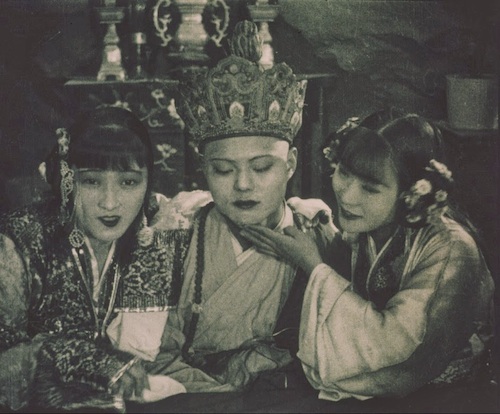
By Joe Bendel. Is it too early to nominate persecuted human rights attorney Pu Zhiqiang for next year’s Nobel Peace Prize? Ai Weiwei’s former lawyer certainly would be a deserving recipient, but the Norwegian parliament might be a little gun shy about acknowledging another Chinese human rights activist given Beijing’s hyperventilating response to Liu Xiaobo’s 2010 Nobel honor. However, a 1927 silent “ghost-spirit” film previously considered lost might have rebuilt some diplomatic bridges (so why not burn them up again?). An incomplete but highly watchable print discovered in the National Library of Norway has since been restored and restituted to China, where hopefully they will keep better track of it this time. Fortunately, the entire world will now have opportunities to see Dan Duyu’s The Cave of the Silken Web, which screened during MoMA’s annual To Save and Project festival of film preservation.
Dan’s Web was one of the first partial adaptations of the mammoth epic The Journey to the West and a leading early example of the mystical ghost-spirit genre. Obviously, it was a hit. After all, the Shaw Brothers did not remake flops. It also encompasses a section of the novel that arguably parallels elements of Homer’s Odyssey, such as Calypso and the Sirens.
The legendary monk Xuanzang had commenced his pilgrimage to India in search of sacred Buddhist texts but he was waylaid by the Spider Queen and her six Spider Hotties in her titular cave. Ordinarily, they would just eat forlorn travelers, but since Xuanzang has the cachet of a monk, the queen intends to marry him. It will be up to his baffled companions, the Monkey King, Pigsty, and Friar Sand to save him from such an un-horrifying fate.
It is easy to laugh at Web’s effects in the post-Avatar era, but at the time it was probably really something to show a woman transforming into a spider. Reportedly, Web also featured nude scenes (that do not survive in the Norwegian print), so it must have been quite a spectacle indeed. Frankly, it is rather charming to see a major silent era filmmaker testing the limits of what film can do. It is also great to have another example of Chinese silent superstar Yin Mingzhu vamping it up as the Spider Queen. Eighty-seven years later, in a print that still carries the scars of time, we can still see her “It-Girl” presence.
Someone ought to program a sequential festival of films based on Wu Cheng’en’s Journey, encompassing the radical stylistic diversity of the animated Monkey King: Uproar in Heaven and Luo Li’s arthouse modernization, Emperor Visits the Hell. It would be great to add Web’s silent eccentricity into the mix. Yet, its vibe is not so very different from Stephen Chow & Derek Kwok’s gleeful cosmic beatdown, Journey to the West.
Web has enormous cultural significance, but it has the extra added bonus of being great popcorn fun. At MoMA, it was paired with China and the Chinese, Part 2, an eighteen minute Benjamin Brodsky newsreel from 1917. It is more of a historical curio, but the footage of the eight year-old acrobat-contortionist still draws an enthusiastic audience response. Highly recommended for fans of arachnid femme fatales and Journey to the West movies, The Web of the Silken Cave should hopefully have many more public screenings in the future at silent movie and Asian themed festivals.
Posted on November 24th, 2014 at 12:14pm.